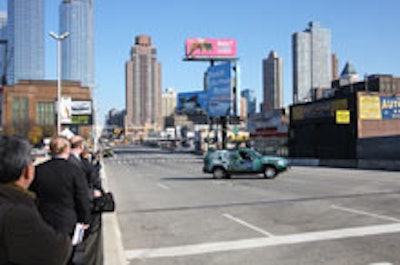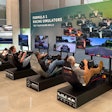Vehicles running down pedestrians and cars almost colliding with each other may be a common sight in New York—especially near Times Square—but for four days this week, on a five-block-stretch of 11th Avenue, these near-misses will be an important component of the World Congress on Intelligent Transportation Systems.
The annual convention gathers policy makers, car manufacturers, and technology companies to discuss and demonstrate new vehicle gadgetry and traffic management systems. The 2007 show was held in China, and this year New York is the host of the five-day summit, which began on Sunday and will run through Thursday, November 20. Held at the Jacob K. Javits Convention Center, the expo is expected to attract more than 10,000 attendees from 45 different countries.
Looking for interactive and engaging ways to showcase new technology for accident prevention and traffic navigation systems, the Intelligent Transportation Society of America brought in Barkley Kalpak Associates to turn a city street into a theater where the convention could stage live demonstrations. As the city and state departments of transportation have a vested interest in the World Congress, the producers were able to work with officials to get permission to close off 11th Avenue and coordinate their efforts with the N.Y.P.D.
Although the street demonstrations are for the car makers to play up products that will be sold to consumers, another activity focuses on the instruments that technology developers want in the hands of automotive brands. To do this, the production team outfitted buses with Vehicle Infrastructure Integration devices—tools that communicate with roadside equipment and stream real-time data to passengers about congestion, weather conditions, and toll pricing—and are providing tours of the city to show how they work.
For government officials like Åsa Torstensson, the minister for communications at Sweden’s Ministry of Enterprise, Energy, and Communications, and Tyler Duvall, the U.S. Department of Transportation’s acting under secretary for transportation policy, Barkley Kalpak designed an interactive 45-minute show in a 3,200-square-foot section of the exhibit floor. Combining several applications and technical data from different technology developers, the producers are staging a video presentation accompanied by two actors to simulate what a traffic control center would look like in 2020.
Next year the World Congress travels to Stockholm, and in 2010 will be held in Busan, Korea.


























